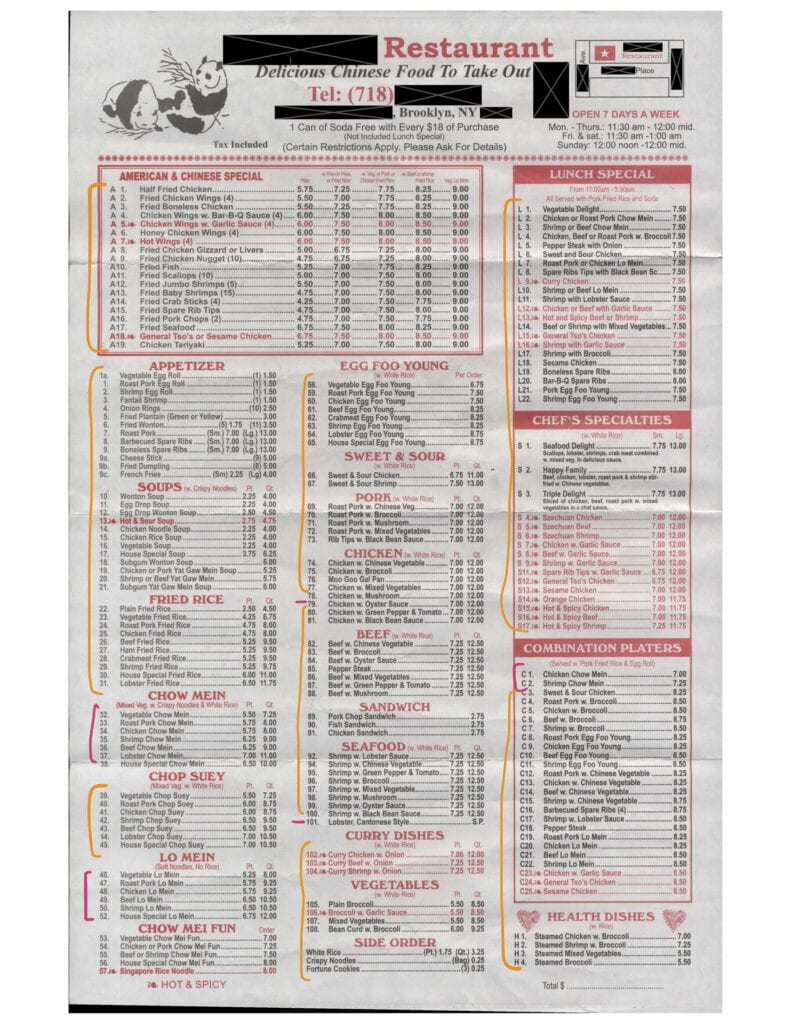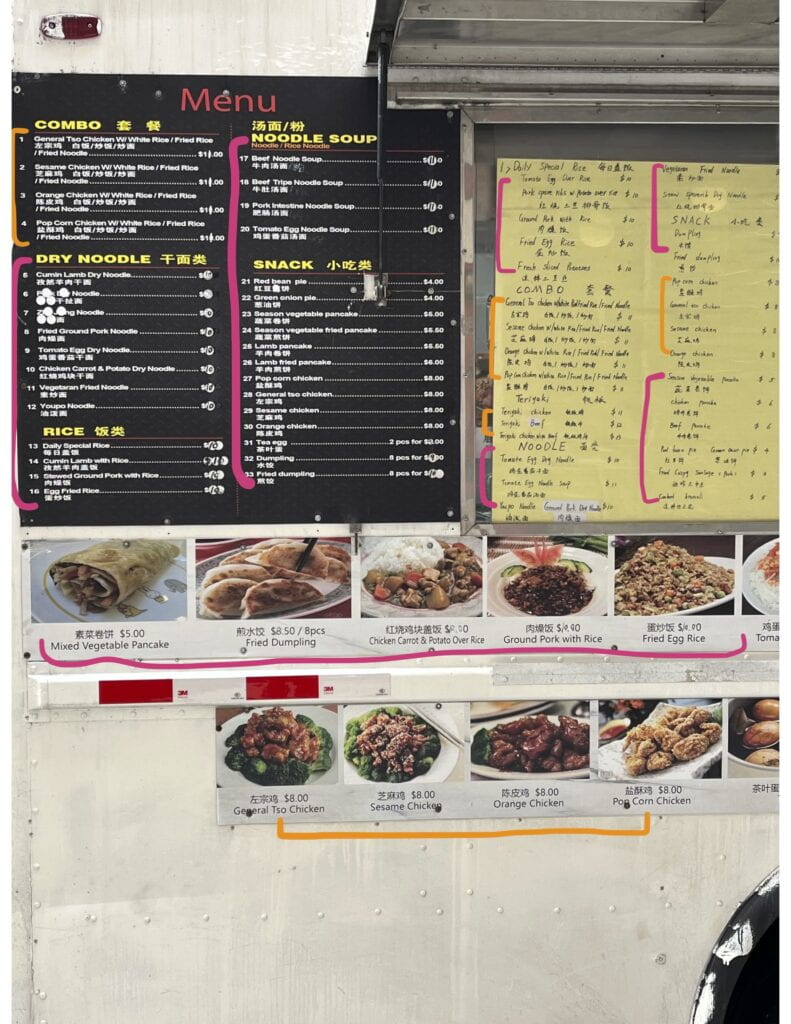It's a way for us to live together and make support for each other. What the Chinese American Takeout restaurant represents for Interviewee Person B - April 4th, 2022 Interview
Americanized Chinese food holds a unique place in American culture. Jewish people have a tradition of eating Chinese food on Christmas as far back as the early 20th century. Or as Robert Siegel, the host of All Things Considered, a NPR podcast, describes it, “Chinese food on Christmas has become as American Jewish as apple pie.” But, what is Chinese food in America? From which region of China did Chinese American food originate? Who are the Chinese chefs and restaurant owners and what is their role in understanding Americanized Chinese food?
While many infamous Chinese restaurants are found in Chinatowns, the Americanized Chinese Takeout businesses defined in this project cater to non-Chinese patrons. According to Sarah Sun’s “Distribution of Chinese Restaurant” map, the neighborhoods these restaurants reside in hardly have any Chinese cuisine at all. Jennifer 8 Lee pointed to the benchmark most likely to “breed great Chinese restaurants” in The Fortune Cookie Chronicles. Usually, these cities have large middle-class Chinese immigration, good economy and a large demand for authentic Chinese food. Interestingly, the Chinese Americanized cuisine pinpointed in this project are mom-and-pop shops, requiring intensive physical labor to sustain.
This video gives examples of Chinese food:
The two menus below are examples of Chinese menus that incorporate both Chinese cuisine from China and Chinese American cuisine. Chinese dishes are outlined in pink and Chinese American dishes are outlined in orange.
The Chinese diaspora has always built communities in coastal regions. Chinatowns exist on every continent, across many countries. Over time, Chinatowns came to represent certain ideas and exoticism of the Orient, the East Asian, the Chinese. Ruth Mayer in Chinatowns in a Transnational World points to how Chinatownness verges “between realty and fantasy and involves complex interplays of anxiety, xenophobia, eroticization, and desire. The fortune cookie and General Tso Chicken, synonymous symbols of Chinese cuisine in the United States, are not Chinese food at all. This project began with the exploratory goal of discovering the workers behind the bullet-proof glass at your Chinese Takeout restaurants.
Person C asked an extended family member who still lives in her hometown to take this video earlier in 2023. The video shows the home she grew up in. No one lives there anymore and the house is in need of repair but no one has plans to move back to the small rural village.
This project seeks to explore the people who operate Chinese American Takeout restaurants in New York City as part of the fourth stage of Chinese food development (post-1965 non-Cantonese immigration), according to Yong Chen. Through global kinship webs, Chinese immigrants pave the way to stable livings for their immediate families and immigrants that followed the same path. Due to the elusive nature of these networks, this project aims to: discover insight into members of the Chinese American Takeout business and their families, capture experiences they are willing to share, and interpret and organize their archives accurately in ways that can benefit the participants and their families. Understanding that written records are privileged, this project seeks to give evidentiary power back to the participants of the project by redefining sources to include oral interviews and snippets of each participant’s daily lives. The ultimate goal is to utilize narrative power and archival power to benefit the people who work in Chinese American Takeout restaurants, by articulating and compiling the histories of a unique under-researched group.
Thank you
I would like to thank every person that has agreed to open the doors to their past for this project and took time from their busy schedule to speak to me. The courage and honesty evident in these records were beyond anything I could have expected. A few of my interviewees have compared the interview sessions to therapy and I could not be more than happy that my project has had a positive impact of those I seek to document. It is my sincerest hope that this project will give voice to Chinese Americans in the Chinese American Takeout restaurant business and add to the public’s knowledge on Asian American Pacific Islander communities in New York, United States, and around the world. If any person involved in this project wishes to remove any of the documents or interviews they have shared in this project, please contact Jenny Cheng @ chengj0802@gmail.com.
While the goal of this project is to gather stories from Chinese Americans in New York City, these ideas and values do not represent all Chinese Americans or the Chinese American Takeout community.
To respect interviewees’ wishes, some topics were not asked because participants were not comfortable sharing certain aspects of their immigration and restaurant experiences.
Chen, Yong. The Rise of Chinese Food in the United States. American History, June 28 2017. https://doi.org/10.1093/acrefore/9780199329175.013.273
Cheney, Ian. The Search for General Tso. 2015, Taiwan: IFC Films, Film.
Künnemann, Vanessa, and Mayer, Ruth, eds. Chinatowns in a Transnational World : Myths and Realities of an Urban Phenomenon. Florence: Taylor & Francis Group, 2011, page 18. Accessed February 22, 2023. ProQuest Ebook Central.
Lee, Jennifer 8. The Fortune Cookie Chronicles. New York: Twelve. Pages 209-249.
Lee, Micheal. “The Surprising Origins of the Fortune Cookie.” HISTORY, February 11, 2021. https://www.history.com/news/fortune-cookies-invented-chinese-japanese.
Sun, Sarah. “Distribution of Chinese Restaurants.” The data comes from NYC Open Data: DOHMH New York City Restaurant Inspection Results.
Plaut, Joshua. “Why Do Jewish People Eat Chinese Food On Christmas?” Interview by Robert Siegel, All Things Considered, NPR, December 25, 2017. https://www.npr.org/2017/12/25/573415894/why-do-jewish-people-eat-chinese-food-on-christmas.


